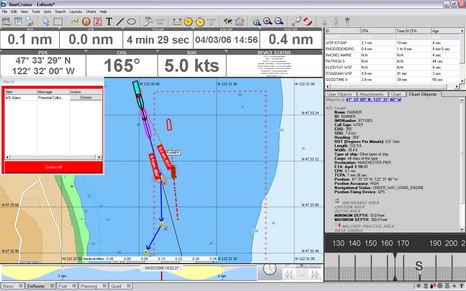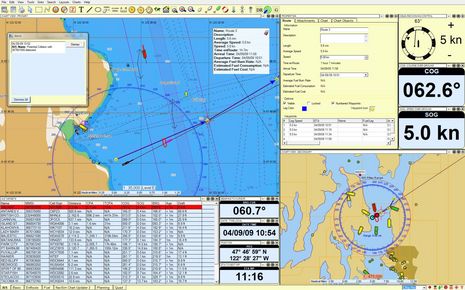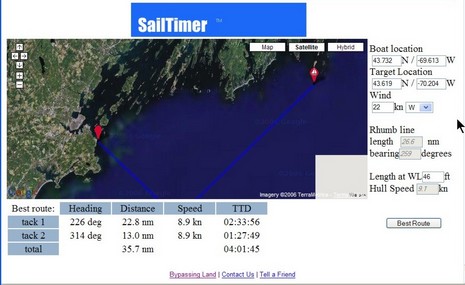Expanded US AIS requirements, good for Class B?

Above, and bigger here, is how NavSim’s new NavCruiser Pro indicates dangerous CPA situations. (And, please folks, if you want to show off how well your AIS application presents CPA info, don’t hesitate to send me screen shots.) But today my real subject is the Coast Guard’s desire to add some 17,000 more vessels to those already required to carry AIS in U.S. waters. Here’s some of the language from a notice about the proposed rulemaking, which may take effect in 2007.
The vessel groups affected are all commercial self-propelled vessels 65 feet or greater (including fishing and passenger vessels), towing vessels 26 feet or greater and over 600 horsepower, vessels carrying 50 or more passengers or certain dangerous cargoes; dredges and certain high speed passenger craft; operating on U.S. navigable waters. We estimate that the number of vessels affected by the AIS portion of this rulemaking is approximately 17,400 foreign and domestic vessels
It is my understanding that this new AIS fleet—which includes, yipee, the Maine state ferries that criss cross my Bays in all conditions plus many of the fishing boats that meander around unpredictably on the offshore Banks—will have the choice of Class A or Class B transponders, and the latter will be on the market this fall. So in the next year, seeing AIS targets will become even more valuable, and the ability to transpond yourself much less expensive. But remember that Class B units only broadcast dynamic data once every 30 seconds, at best. Won’t that make single channel receivers seem noticeably slow on the update? There are other issues with Class B, but they’ll have to wait.













Why are these units as expensive as they are? It seems to me that today electronics are pretty simply stuff… and AIS is a VHF radio which reads a data stream from some transponders and broadcasts it. Just look at what PCs do and what they cost these days!
GPS came on as very expensive and after less than 10 years we have hand held plotters which cost less than 1/10 the cost of the original (non plotter) units. The excuse back then was that it was new technology and the companies needed to recover the R&D costs.
I won’t buy THAT argument for AIS class A or B or the listeners. Obviously some companies such as NASA don’t either and offer their “engine” for as little as U$200.
I sure hope that these class A and B units are offered at reasonable pricing. I do understand that they need to be reliable and robust for commercial use. But hopefully some manufacturers will offer the transponders to the recreational market at a more affordable price.
Unlike radar which does NOT discriminate targets, AIS only displays class A and B transponders and so yachtsmen need to realize that there may be hazards which will not show on their AIS display.
Does anyone think that the Coast Guard will issue further guidelines requiring more vessels to be AIS equipped… eventually including recreational boating?
Jef
sv Shiva
Contest 36s
I realize it’s 0520 and I may be a bit foggy but … on the screen shot can you explain why the tag on the bearing to the vessel Rainer is 011 degrees? It appears to be 011 degrees to port, but shouldn’t it be relative to your own boat’s heading, i.e., 349 degrees?
AIS A Class is so expensive becasue of the cost of IMO aproval for the device + making somthing to read all the inputs and transmit is far more complex than compared to NASA’s ais listner that they didnt design.
I don’t know for certain the answer to the question of expense for AIS Transponders, but here’s my hypothesis.
All AIS Transponders within range of one another dynamically and automatically form a wireless Local Area Network (LAN) using a fairly sophisticated form of Time Division Multiplexing protocol. As Transponders move in and out of range with one another, the participants in the LAN are constantly changing and, as a result, any single Transponder’s “place” in the Multiplexing scheme is constantly changine. The “smarts” that are needed to do this makes the devices considerably more complex than a simple VHF transmitter, such as a VHF RadioTelephone.
It is this sophisticated LAN protocol that permits several hundred transponders to transmit / exchange the ship’s dynamic information every few seconds without interfering with any other transponder’s transmissions and to accomodate a new transponder coming within range and joining the conversation.
Land based Data Comm folk have dealt with this sort of thing, i.e., time division multiplexing, for some time now, except the networks they construct are essentially static in terms of device participation. It is the dynamic nature of the AIS network that makes it all so complicated.
Again just guessing, but I wouldn’t be surprised if the IMO approval expenses are also related to rigorous testing of the transponder’s ability to join into an existing LAN, form a new LAN, depart from a LAN, and deconstruct an existing LAN.
Of course, an AIS Receiver only needs to listen in on the LAN traffic rather than participate fully. Thus, they are a significantly simpler device than a transponder and need be no more than a simple VHF receiver with a bit of “smarts” to interpret the AIS sentences. Hence, an AIS Receiver can be designed and built very cheaply.
Class B is more expensive than expected for a few reasons:
1. The hardware is not significantly different from a class B. You still need receivers and a transmitter — the only real difference being the power level.
2. The USCG wants frequency agile Class B as well as DSC receive support. This makes them alot harder to design and build than a fixed frequency design.
3. The software is slightly less complicated than Class A, but it still has to deal with channel management commands which means a more expensive processor in the device. Throw out message 22 and 23 and the system complexity goes way down.
4. Certification is expensive. There are only a few places that can run the tests and they charge accordingly.
5. The market really is not that large. Assuming the 17,400 number is correct, how many would you expect to voluntarily buy a Class B? Not 100% — another reason you see manufacturers supporting mandatory carriage requirements.
Brian
Brian:
I both agree and disagree with you….
Class B ARE significantly different to Class A in their RF designs and interface requirements and CAN be made much significantly cheaper, the question is, can they be made cheap ENOUGH!
DSC support does complicate matters as well and it would be nice to dump it, but that ain’t gonna happen.
There are now chips on the market that do a lot of the complicated stuff for you, so designs SHOULD become cheaper.
If you compare the Class B specifications against a typical Land based radio or a Marine VHF radio, you will see that they are considerably more strict, which is why they are unlikely to ever be as cheap as your VHF voice radio. It’s relatively easy to build a Class B that works, its a world of difference to get one that meets the standard….
Oh, and I thought that the reporting rate for Class B’s gets faster if they are doing over 14knots, so that 30s for everything going slower shouldn’t be a problem.
Class B’s fastest autonomous rate is 30 seconds. It can be commanded by a base station to report as fast as 5 seconds, but that would not be a normal case.
Singapore announced last year plans to equip all small harbour craft and pleasure craft with AIS transponders (they call it HARTS). Notice appeared at http://www.singapore-window.org/sw05/050701a1.htm
As reported in the SEA Yachting magazine, Vol 1 No 5, July-August 2006, they now have published details which say that all craft registered in Singapore prior to 1 Jun 2006 will have the transponders purchased and fitted by the government for FREE. Vessels registered after that date will be required to purchase and fit them at their own expense.
HARTS – $1000 and not compatible with foreign vessels’s AIS.
Big Brother & a very nice contract for someone. Why didn’t they just put US$300 AIS transceivers on board instead?